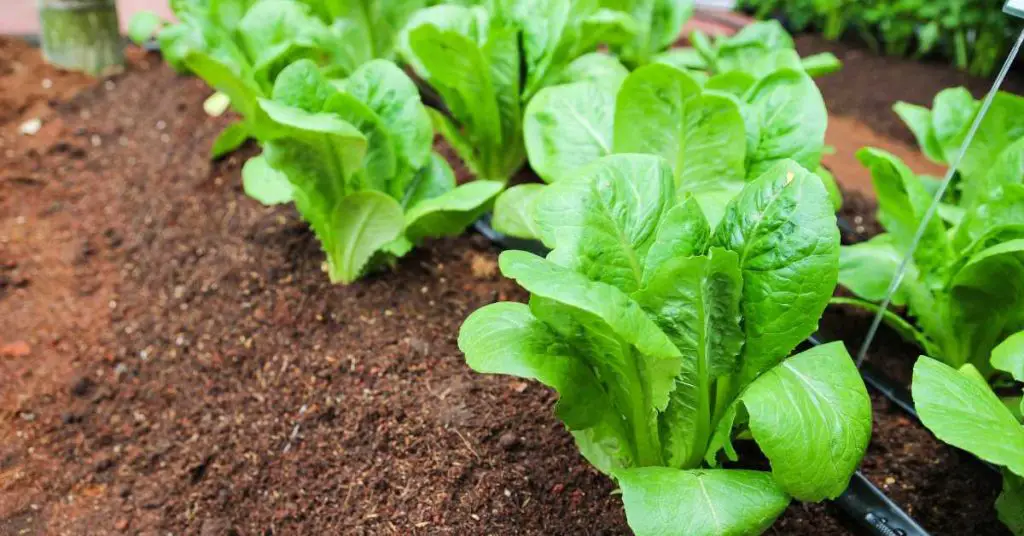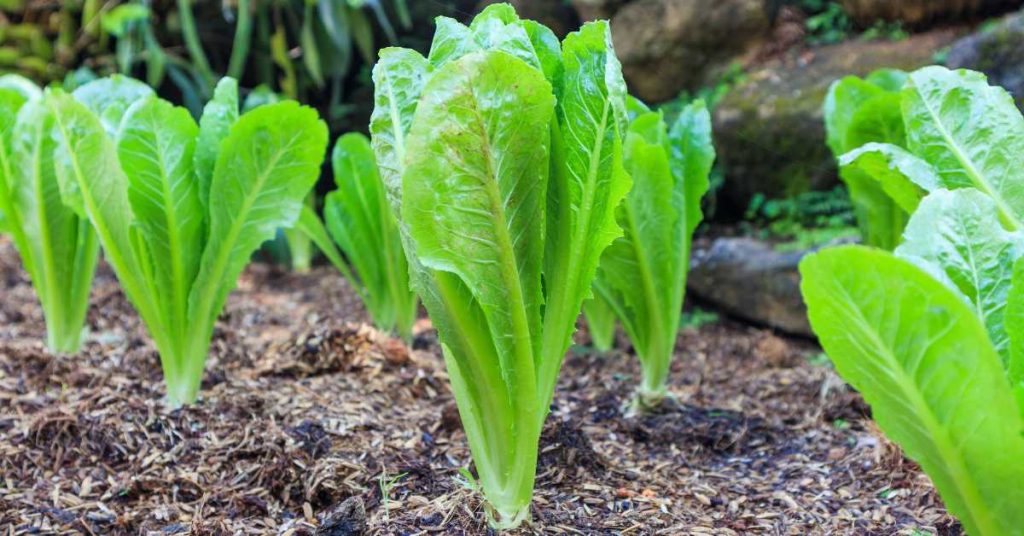Did you know that you can enjoy a continuous supply of fresh, crisp romaine lettuce simply by cutting it and allowing it to regrow? It’s true! According to research conducted by horticulturists and plant scientists, romaine lettuce has the remarkable ability to regrow after being cut.
In fact, studies have shown that up to 75% of romaine lettuce plants can regrow successfully when properly cared for. This means that you can have a bountiful harvest of this nutritious green without having to constantly replant new seeds or purchase more lettuce from the store.
By understanding the anatomy of romaine lettuce and providing it with the optimal conditions for regrowth, you can enjoy a sustainable source of fresh, homegrown lettuce all year round.
In this article, we will delve into the fascinating process of romaine lettuce regrowth, explore the techniques for cutting and caring for the plants, and discuss the potential challenges and limitations associated with this practice.
Get ready to embark on a journey of sustainable gardening and discover the wonders of romaine lettuce regrowth!
Key Takeaways
- Romaine lettuce regrows after being cut, with up to 75% of plants regrowing successfully.
- Adequate sunlight, moisture, and nutrients are necessary for regrowth.
- Romaine lettuce regrows from dormant buds called axillary meristems.
- Proper cutting techniques involve selecting a mature plant and leaving inner leaves intact.
Understanding the Anatomy of Romaine Lettuce
Did you know that romaine lettuce, like other types of lettuce, has a complex anatomy? It includes a crunchy stem and vibrant green leaves. Understanding the anatomy of romaine lettuce is key to understanding its regrowth potential.
When you cut the romaine lettuce, you’re essentially removing the top portion of the plant, known as the crown. This crown contains the apical meristem, which is responsible for the plant’s growth and regrowth. After cutting, the crown has the ability to regenerate and produce new leaves, leading to regrowth.
However, it’s important to note that regrowth may vary depending on factors such as environmental conditions, nutrient availability, and overall plant health. While romaine lettuce has the potential to regrow after cutting, it’s crucial to provide the proper care and conditions for optimal regrowth.

Exploring the Regrowth Potential in Romaine Lettuce
Exploring the regrowth potential, you’ll be amazed at how romaine lettuce can bounce back after being trimmed. Romaine lettuce has the remarkable ability to regrow when properly nurtured.
The regrowth process begins with the remaining leafy base, known as the crown, which contains dormant buds called axillary meristems. These meristems are vital for initiating new leaf growth. With the right conditions, such as adequate sunlight, moisture, and nutrients, the axillary meristems start developing into new leaves, allowing the lettuce to regenerate.
The benefits of regrowing romaine lettuce are numerous. Firstly, it offers a continuous supply of fresh, homegrown greens, reducing the need for frequent trips to the grocery store. Additionally, regrowing lettuce is cost-effective and environmentally friendly, as it reduces food waste.
Embracing the regrowth potential of romaine lettuce allows you to enjoy the satisfaction of nurturing your own food while promoting sustainability.
Tips for Properly Cutting Romaine Lettuce for Regrowth
By carefully snipping away the outer leaves, romaine lettuce reveals its hidden potential for a vibrant regrowth, like a phoenix emerging from its ashes.
To make the most of this regrowth potential, follow these cutting techniques:
- Start by selecting a mature romaine lettuce plant with a firm and healthy base.
- Use a sharp and clean pair of shears to cut the outer leaves of the lettuce plant about 1-2 inches above the base.
- Leave the inner leaves intact to allow them to continue growing and provide nourishment for the regrowth.
After the cutting process, the regrowth time for romaine lettuce can vary depending on environmental factors such as temperature and sunlight. On average, it takes about 2-3 weeks for the lettuce to regrow to a harvestable size. However, with proper care and maintenance, you can enjoy a continuous supply of fresh romaine lettuce by harvesting outer leaves and allowing the inner leaves to regrow.
Creating the Perfect Environment for Regrowth
To ensure a successful regrowth, you can create the perfect environment by providing adequate sunlight, maintaining a consistent temperature, and regularly watering your romaine lettuce plant. Creating a regrowth friendly environment is crucial for optimizing regrowth conditions.
Lettuce plants thrive in full sun, so placing your plant near a window or providing artificial light for at least 12 hours a day will ensure it receives enough sunlight. A consistent temperature between 60 to 70 degrees Fahrenheit is ideal for romaine lettuce.
Avoid extreme temperature fluctuations as they can hinder regrowth. Additionally, watering your plant regularly is essential to keep the soil moist but not waterlogged. Overwatering can lead to root rot, so make sure the soil drains well.
By following these steps, you can provide the optimal conditions needed for successful regrowth of your romaine lettuce.
Watering Techniques for Maximizing Regrowth
Watering techniques play a crucial role in maximizing the regrowth potential of your romaine lettuce plant. To ensure the maximum growth and regrowth of your lettuce, it’s important to follow precise and technical practices.
Here are some research-based tips to help you maximize your romaine lettuce’s regrowth potential:
- Proper watering frequency: Water your lettuce plant consistently, keeping the soil moist but not overly saturated. Avoid letting the soil dry out completely between watering sessions.
- Deep watering technique: Water the plant deeply, allowing the water to penetrate the root zone. This encourages the roots to grow deeper, promoting stronger regrowth.
- Mulching: Apply a layer of organic mulch around the base of the plant to help retain moisture in the soil, reducing water evaporation and maintaining optimal moisture levels.
- Drip irrigation: Consider using a drip irrigation system that delivers water directly to the root zone, minimizing water waste and ensuring efficient and targeted watering.
By implementing these watering techniques, you can maximize the growth and regrowth potential of your romaine lettuce plant. Remember to provide consistent moisture and create an optimal environment for your lettuce to flourish.
Harvesting and Using Regrown Romaine Lettuce
Once you’ve harvested your regrown romaine lettuce, get creative in the kitchen and explore the endless possibilities of using this fresh and flavorful leafy green. Romaine lettuce has a high regrowth potential, making it an excellent choice for those who want a continuous supply of lettuce.
When regrowing romaine lettuce, it’s important to follow proper regrowing techniques to ensure successful regrowth. After cutting the lettuce, leave about 1 to 2 inches of the base intact, as this is where new leaves will sprout from. Place the base in a container with water and change the water every few days to keep it fresh.
Once new leaves start to grow, you can transplant the lettuce into soil or continue growing it hydroponically. Remember to provide adequate sunlight, water, and nutrients for optimal regrowth. With proper care, you can enjoy a bountiful harvest of regrown romaine lettuce.

Common Mistakes to Avoid When Regrowing Romaine Lettuce
Avoid the hilarious blunder of forgetting to leave a couple of inches of the base intact when you hack away at your regrown romaine lettuce. This common mistake can prevent your lettuce from regrowing properly.
When regrowing romaine lettuce, it’s essential to understand the regrowth process. After cutting the lettuce, the base needs to be placed in a container of water. This allows the plant to absorb nutrients and water, stimulating regrowth. It’s crucial to change the water regularly to prevent bacterial growth.
Another mistake to avoid is overcrowding the container. Each lettuce base needs enough space to grow without competition. Additionally, ensure that the container is placed in a well-lit area, as lettuce requires adequate sunlight for photosynthesis.
By avoiding these common mistakes and following proper regrowing techniques, you can successfully regrow your romaine lettuce and enjoy a continuous supply of fresh, homegrown greens.
The Role of Nutrition in Romaine Lettuce Regrowth
Proper nutrition plays a vital role in the successful regrowth of romaine lettuce. The regrowth process in romaine lettuce after cutting is a complex biological phenomenon that relies on the availability of essential nutrients.
When a romaine lettuce plant is cut, it triggers a response known as wound healing, which involves the activation of specific genes and the redirection of nutrients to support new growth.
Nutrients such as nitrogen, phosphorus, and potassium are particularly important for this regrowth process. Nitrogen is necessary for leaf development, phosphorus supports root growth, and potassium aids in overall plant health and vigor.
Additionally, other micronutrients like iron, zinc, and manganese are required in smaller quantities for optimal regrowth.
It is crucial to provide these nutrients through a balanced fertilizer or compost to ensure successful regrowth of romaine lettuce after cutting.
Comparing Regrowth Potential in Different Lettuce Varieties
Now let’s delve into the fascinating world of comparing regrowth potential in different lettuce varieties.
As a horticulturist or plant scientist, you’d be interested in understanding the intricate process of regrowth in romaine lettuce after cutting.
When it comes to lettuce regrowth benefits, it’s important to consider the various methods available for comparison.
Scientific research and studies have shown that certain lettuce varieties have a higher regrowth potential than others.
By comparing regrowth methods, we can determine which techniques are most effective in promoting regrowth in romaine lettuce.
This information can help us optimize our cultivation practices and ensure a bountiful harvest.
However, it’s crucial to remain objective and impartial, acknowledging any limitations or challenges associated with the regrowth process.
By incorporating these insights, we can cultivate a sense of belonging among lettuce enthusiasts and foster a community of informed growers.
Other Vegetables That Can Regrow After Cutting
Imagine the thrill of discovering that other vegetables, such as celery and green onions, have the incredible ability to regenerate and grow anew after being harvested. In the world of horticulture, regrowth potential in celery and other vegetables is a fascinating topic.
When it comes to regrowing celery, it’s all about utilizing the base or the bottom part of the stalk that we usually discard. By placing the base in a container with water and providing it with the right conditions, it can sprout new leaves and eventually develop into a full-sized plant.
This regrowth process is also possible with green onions, where the white bulb at the base can be placed in water to stimulate new growth.
Additionally, regrowing herbs at home is another popular practice among plant enthusiasts. By simply cutting off a portion of the herb’s stem and placing it in water or soil, it can regrow and provide a fresh supply of herbs for culinary use.
So, if you’re looking to expand your garden and have a continuous supply of fresh vegetables and herbs, exploring the regrowth potential in celery and herbs is certainly worth considering.
Sustainable Gardening Practices for Continuous Harvesting
Get ready to experience the joy of a never-ending harvest by adopting sustainable gardening practices in your garden. By implementing continuous harvesting techniques, you can ensure a steady supply of fresh romaine lettuce throughout the growing season.
Romaine lettuce, a member of the lettuce family (Lactuca sativa), has the ability to regrow after cutting, allowing you to enjoy its crisp leaves multiple times. When harvesting romaine lettuce, it is important to leave the crown intact, as this is where regrowth will occur.
As the plant regrows, it will produce new leaves from the center of the crown, allowing for a continuous harvest. This regrowth process is facilitated by the presence of apical meristems, which are found in the growing points of the plant.
By practicing sustainable gardening and regrowing lettuce, you not only reduce waste but also save money and ensure a constant supply of fresh greens.

Frequently Asked Questions About Romaine Lettuce Regrowth
One common question people have about regrowing romaine lettuce is how long it takes for the new leaves to appear after harvesting. The regrowth process in romaine lettuce begins with the reactivation of dormant buds located in the leaf axils. These buds then develop into new leaves, which emerge from the center of the plant.
It typically takes about 10 to 14 days for the new leaves to become visible after cutting.
Regrowing romaine lettuce offers several benefits. Firstly, it allows for continuous harvesting, providing a constant supply of fresh, nutrient-rich leaves. Additionally, regrowing lettuce can be a sustainable gardening practice as it reduces waste and saves money on buying new plants. Moreover, regrown lettuce may have a sweeter taste and a more tender texture compared to store-bought lettuce, making it a preferred choice for many home gardeners.
Understanding the anatomy of lettuce and the process of regrowth can help you successfully grow and harvest your own romaine lettuce at home.
Frequently Asked Questions
How long does it take for romaine lettuce to regrow after cutting?
Romaine lettuce can regrow after cutting, but the regrowth speed varies. It typically takes around 2-3 weeks for new leaves to appear. Regrowth methods include placing the cut base in water or planting it in soil.
Can I regrow romaine lettuce from store-bought heads?
You can regrow romaine lettuce from store-bought heads, even in small spaces. Regrowing lettuce at home has numerous benefits, including access to fresh produce and reduced waste.
Will regrown romaine lettuce have the same taste and texture as the original head?
When regrown, romaine lettuce may have a similar taste and texture to the original head. However, variations in growing conditions and nutrient content could affect the final result, making it hard to guarantee an exact match.
Do I need to use any special fertilizers or nutrients to promote regrowth?
To promote regrowth in romaine lettuce, you can use special fertilizers and nutrients that provide essential elements like nitrogen, phosphorus, and potassium. These will support the plant’s growth and help it recover after cutting.
Can I regrow romaine lettuce indoors, or does it need to be grown outdoors?
You can successfully grow romaine lettuce indoors, even in small spaces. Indoor gardening has numerous benefits, such as easy access to fresh produce and a sense of belonging to a community of like-minded gardeners.
Conclusion
In conclusion, regrowth is possible in romaine lettuce after cutting, making it a sustainable option for continuous harvesting. Research has shown that when properly cut, romaine lettuce can regrow new leaves from the base. This process, known as stem regeneration, allows for an ongoing supply of fresh lettuce.
However, it’s important to note that regrowth potential may vary between lettuce varieties and environmental conditions. By creating the perfect environment and using proper watering techniques, you can maximize regrowth. Remember, sustainable gardening practices are key to ensuring a bountiful harvest.
So, grab your shears and start enjoying the benefits of regrown romaine lettuce in your garden. Just like nature’s resilience, the regrowth of romaine lettuce is a testament to the beauty and abundance that can arise from a single cut.





